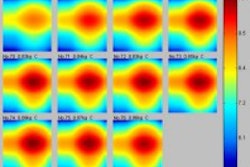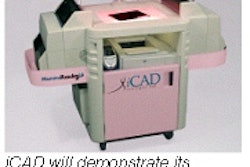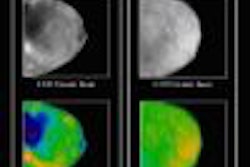LAS VEGAS - A 1.6% boost in Medicare physician fees, expected to take effect March 1, will be especially welcome for breast centers struggling to make ends meet. But centers can impact the bottom line much more effectively by focusing on expenditures instead of reimbursement.
Decreasing fixed expenses through productivity and throughput, empowering technologists and support staff, and enacting performance measures are just a few of the ways breast centers can survive and thrive, said Gerald Kolb during a talk Tuesday at the National Consortium of Breast Centers conference. Kolb is the president of Breast Health Management, a consulting firm in Bend, OR.
The Medicare increase, part of a $400 billion spending bill signed by President Bush this week, will mean a few more dollars for screening, diagnostic, and digital mammograms, Kolb said.
Computer-assisted detection (CAD), already covered by Medicare for film-screen exams, will also be reimbursable in combination with full-field digital mammography (FFDM) exams beginning April 1.
"These are not big increases, but at least we are in positive territory," he said. "This allows us to be more proactive instead of reactive in our financial outlook, which means controlling costs -- and that is always easier than increasing reimbursement."
Applying basic economic models to breast center operations, such as analyzing variable versus fixed expenses, volume, and productivity, can yield surprisingly profitable results.
Variable expenses such as laundry, film, and postage can be tough to reign in, as they are highly volume-dependent. The more procedures performed, the more resources used. The best way to save on variable expenses is by negotiating the most favorable deals possible with suppliers, Kolb said.
The road to productivity
But variable expenses are small change compared to fixed costs. Equipment and staff comprise the largest component of fixed costs, and their impact can vary greatly depending on procedure volume. This line of questioning leads directly to productivity.
"Productivity is a nasty word in some circles, because it means someone is keeping track of how long it takes you to do a task," he said. "But productivity is your friend, because it allows you to optimize all of your resources."
Technologists are the first stop on the road to higher throughput, Kolb said. But simply changing the center’s schedule from 30-minute appointments to 15-minute slots is the wrong approach. Instead, assess what kinds of tasks technologists are actually doing throughout the course of the day.
Too many breast centers pile on time-consuming jobs unrelated to patient scanning, such as acquiring extended patient histories, transporting laundry from exam rooms and changing areas, and restocking film supplies.
"One of the first productivity moves you can make is to sit down with your technologists and ask them what you can do to make their jobs easier," Kolb said. "Find out how they are really spending their time. I guarantee that the next half-hour will be the most illuminating time you have ever spent."
Hiring a technology aide can relieve skilled technologists of low-level tasks, he said, and open up time on the scanning schedule.
Developing and enacting measures to quantify performance is also key. This goes beyond quarterly, bottom-line reports, he said. Analyzing mammograms per month per unit is one such assessment; another is mammograms per month per FTE technologist.
Don’t make the mistake of relying on the center’s schedule to evaluate productivity, Kolb said.
"Just because you have a 15-minute screening schedule doesn’t mean you’re productive," he said. "Most sites where I consult are hard-pressed to hit 65% utilization. They look busy, everyone feels busy, but when you add up the no-shows and other things, they are not productive."
Such assessments should be conducted and compared over time, not just once, he added. And while 100% utilization is unrealistic, in order to use resources most efficiently, a center should strive for a figure that is in the high 90% range. To do so, it’s critical to understand the source of empty slots in the schedule, Kolb said.
"Is it because you’ve got no-shows? Or is it because one of the technologists has asked the scheduler to leave an open slot in the day for every tech so that they can get their paperwork done?" he said. "It’s not bad to block off spots, but you have to know what is being blocked off and why. It has to be part of the decision process."
RIP for the lunch bunch?
It’s common for centers to automatically assume that four scanning slots per day will be lost to the lunch hour, Kolb said. This needs to be reassessed.
At this point it's important to ascertain if screening slots are really slots. When slots aren't really available, they're not really part of the pool, he said, adding that someone also needs to decide if it's wise to shut down an expensive technology "simply because the group all wants to have lunch at the same time."
When technologists are made aware of the financial implications that shutdown involves, they are often the first to come up with creative solutions, Kolb said. But staffers must be empowered with this knowledge in order to help make decisions.
"It’s bottom-up management, and it works," he said.
While Kolb’s strategies are focused on fiscal management, his goal is not simply to make breast centers "money-making machines," he said. Positive cash flow enables centers to provide internal funding for vital services that typically receive either low or no reimbursement.
"Wouldn’t it be wonderful to have a breast-specialist nurse available for every patient who goes beyond a screening mammogram?" he said. "Or to have an aide who is available to be on the arm of every patient going through the trauma of breast cancer? Nobody pays for these things, but by enhancing the bottom line, we can find the money for these things that are so important."
By Deborah R. DakinsAuntMinnie.com contributing writer
February 27, 2003
Related Reading
Ten points of the new healthcare architectural design, February 10, 2003
Go with the flow: Is your facility designed for maximum utilization?, November 18, 2002
Innovative programs cut through mammography's crisis, October 17, 2002
Radiology extenders -- the answer to the RT personnel shortage?, September 19, 2002
E&M codes help breast centers thrive, March 26, 2002
Copyright © 2003 AuntMinnie.com



















